I’ve been in the hospital the last few days, totally unexpectedly. Seems as though I misdiagnosed what I thought was heartburn for far too long. Turns out it wasn’t. One stent later the guys in the operating room proved it to me. All numbers back to normal now, and I feel good, but if I’d delayed any later, maybe not.
July 2022
Thu 21 Jul 2022
Sun 17 Jul 2022
JAMES E. MARTIN – The Flip Side. Gil Disbro #2. Putnam, hardcover, 1990. Avon, paperback, 1991.

While Cleveland-based PI Gil Disbro had a respectable four-book run in the early 1990s from a couple of major publishers, he doesn’t seem to have made much of an impression on the mystery reading public. Reviews of his books on the Internet are relatively few, and as is the case with several other PI’s of the same era, he’s generally forgotten now.
In The Flip Side, his second outing, the case builds from almost nothing to a complicated tale of kidnapping and two murders. He’s hired by the shy tutor (female) for the young son of a college professor, both of whom have disappeared. Just another missing persons case, he thinks, more suitable for the police to handle, he thinks, if even there is a case.
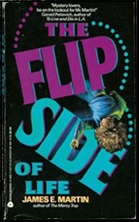
It doesn’t take him long, though, to learn how wrong he is. Luckily, though, Disbro is one of those guys whom the people he questions start telling their entire life stories to. If he wasn’t, I don’t think he’d have much of a career as a private investigator. But he’s also persistent, in the well-established Lew Archer sense, if not out and out doggedness, and closes out the case in fine fashion.
Since he tells his story in first person, it takes a while to tell what kind of person he is, inside and out. He’s young, dressed casually, and while a heavy smoker, doesn’t drink a lot. He lives with a college professor (female) who is a few years older than he is, but he (unfortunately) can be seduced by one of his suspects (also female) for no good reason.
Overall, though, a better than average outing. I’d read another, if one comes along, but without the urgency of needing to hunt down another, if that makes sense.
Sun 17 Jul 2022
Archived Mystery Review by Maryell Cleary: LEE THAYER – Guilt Edged.
Posted by Steve under Reviews[3] Comments
LEE THAYER – Guilt Edged. Dodd Mead, hardcover, 1951. Unicorn Mystery Book Club, hardcover, four-in-one edition. No paperback edition.
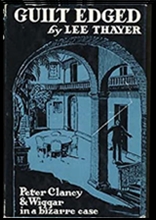
Here’s a book that has everything – old N’Orleans atmosphere, poor but grand old Southern. families., Creole legends, faithful family retainers (“colored” servants), an inexplicable stabbing, a lovely girl — but why go on? The detective is Peter Clancy, with his English “man” Wiggar. They work along with good-natured, but not too swift Chief of Detectives Burns.
The trouble is that Peter Clancy is not too swift either. His reason for being in New Orleans is a mysterious letter – anonymous and made up of cut-out printed words, of course — with an enclosure, a gold certificate for $1000. For those of us who don’t remember, gold certificates are yellow on one side. “Guilt edged,” get it?
Despite the scattering of clues wholesale in front of Clancy’s eyes, he sleuths away on other tracks until light finally dawns. Long after it dawned on me. Sorry, folks, good detect1ng it ain’t; if you like atmosphere laid on with a trowel, it may be for you.
Sat 16 Jul 2022
Reviewed by David Vineyard: PAUL STANTON – Village of Stars.
Posted by Steve under Reviews[5] Comments
PAUL STANTON – Village of Stars. M. S. Mill/William MOrrow, hardcover, 1960; Permabooks M4230, paperback, 1962.

Nothing so defined the 1950’s and the early 1960’s as the novel of nuclear terror. Some were science fictional post apocalyptic novels like Philip Wylie’s Triumph and Pat Frank’s Alas Babylon, while others were strictly thrillers like Ian Fleming’s Thunderball and Wylie’s (again) The Smuggled Atom Bomb. There were tense warnings of the dangers of nuclear brinksmanship like Eugene Burdick’s Fail Safe and Peter George’s Red Alert (which became the black humor of Dr. Strangelove) and frightening tales of that brinksmanship gone too far like Nevil Shute’s On The Beach.
Village of Stars was probably the first one of these book I ever read at age twelve. The man behind the pseudonym Paul Stanton was David Beaty, a fine British aviation novelist in the Nevil Shute/Elleston Trevor tradition who was best known for Cone of Silence.
The set up for the novel is fairly simple, and riveting.
There is a crisis in the Middle East, it is getting hotter by the hour. Russian troops are on the move and the West is taking note. Sabers are rattling.
Helen Durrant is the personal assistant to Air Marshal Chatterton when she meets Squadron Leader John Falkner. The chemistry is almost immediate, and like people living on the edge in any place in the world things move pretty quickly. At the same time things are moving quickly in the Middle East.
The gesture was more formal, more possessive than a kiss. And the sense of having moved irrevocably to some unknown destination returned.

Our main characters set and the milieu of impending nuclear war there to ratchet up tension it is inevitable that Falkner will be sent on a mission to the hot spot, that while he is on patrol the tension comes to the boiling point. So much so that Falkner has to take a step he has never taken before.
One of his nukes, F6, is armed. F6 is capable of destroying a 40,000 square mile area. And for a few tense moments the world sits on the edge of the razor. Then the order comes.
The Russians have withdrawn. They are pulling back.
Falkner and crew can breathe a sigh or relief.
The fuse can be disarmed. But you can’t always put the djinn back in the bottle.
K6, the nuke, will not defuse. There is no way for Falkner and his crew to defuse the bomb.
They are near the limit of their flight path, fuel is getting low. There is no place on Earth they can reach and safely dump the nuke, and if the ship drops beneath 5,500 feet the nuke will detonate. If they crash into a mountain above 5,500 feet the nuke will detonate.
There is one chance in the Arctic Sea, but when they reach that spot there are ships from the Russian fleet there. Dropping K6 or even ditching would trigger WWIII.
What now? As they fly over Greenland Falkner wonders what if he just dumped the nuke in the ocean, saved the life of his crew and took the consequences. Who could really blame him?
There is one last chance if they have enough fuel, a landing field at Nairobi at 5,700 feet. Awfully close, but still, a chance, with two hundred feet to spare…
He had an areodrome to land at – that was enough for him.
The hero chooses not to think about it, but Stanton is perfectly happy to let us sweat it out. There is a streak of sadism in good suspense writers that has never been sufficiently explored.
Village of Stars is a heavy breather, a well written two-fists on the wheel read, that builds up, in its relatively short length, considerable suspense. It is tightly written, and would not work half as well as a bloated best seller. Stanton/Beaty keeps the story moving, switching between characters and settings, avoiding the tiresome soap opera of most bigger books to focus on the immediate problem and danger, which in this case is more than enough.
By the time you reach the end, even if it is all a little dated today, you may want a hug and a drink like John Falkner. It’s still a hell of a ride.
Thu 14 Jul 2022
A PI Mystery Review by Tony Baer: MICKEY SPILLANE – Kiss Me, Deadly.
Posted by Steve under Mystery movies , Reviews[10] Comments
MICKEY SPILLANE – Kiss Me, Deadly. Mike Hammer #6. Dutton, hardcover, 1952. Signet #1000, paperback, 1953. Reprinted many times.

So, yeah, this is my third crack at Mike Hammer (previously having read I, the Jury and One Lonely Night). I was a big fan of the Stacy Keach TV show Mickey Spillane’s Mike Hammer in the 80’s. Which I think may be part of the reason why I keep trying to enjoy the books — results be damned.
In this yarn, Mike Hammer finds himself cruising down the highway between Albany and Manhattan when an escapee from the loony bin leaps in front of his coupe wearing only an overcoat. He picks her up. Shenanigans ensue.
They get rolled by the mafia, literally rolled off a cliff, and Hammer gets framed for the lady’s murder.
Turns out the lady he picked up was the moll of a that guy bilked the mafia out of $2 million bucks worth of merchandise. And now the mafia thinks Hammer knows where it is. He’s got to get the goods and kill the bad guys before they kill him. And this time he’s without his trusty .45 as the FBI pulls his license. So it’s two-fisted action for Hammer. But the results are never truly in doubt. If there’s one thing Hammer doesn’t lack, it’s self-confidence.
—
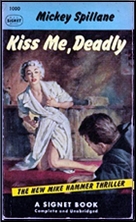
I think Spillane may be a better writer than he gets credit for. His prose isn’t half bad half the time:
“Trouble. Like the smoke over a cake of dry ice. You can’t smell it but you can see it and watch it boil and seep around things and know that soon something’s going to crack and shatter under the force of the horrible contraction….”
“I went to say something. It never came out. The moon that had been hidden behind the clouds came out long enough to bathe the earth in a quick shower of pale yellow light that threw startlingly long shadows across the road and among those dark fingers was one that seemed darker still and moved with a series of jerks and a roar of sound that evolved into a dark sedan cutting in front of us.”
And he’s quite good at action scenes, clipped and visceral: “I had my hand clamped over his, snapped it back and he screamed the same time the muzzle rocketed a bullet into his eyeball and in the second before he died the other eye that was still there glared at me balefully before it filmed over.”
—
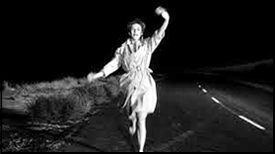
The problem is really just that Mike Hammer is a jerk. And the dialogue that comes out of his mouth is frequently so stupid it stretches credulity: “Get your nose to the ground, kitten……Velda…..Show me your legs.” His mouth just utters one cliche after another. You couldn’t use much of the tired patter at all now for any film script other than parody.
The other problem is the plot. You get the feeling Spillane doesn’t know ‘who did it’ either. He’s like Mike Hammer. He figures if he keeps punching and punching the typewriter and Hammer keeps punching and punching the bad guys, at some point he’ll make it. Heroes turn villains and villains turn hero on a dime, with little explanation. Motives are as hazy as are lines of authority and control. In the end all you know is that Mike Hammer metes out justice and all the bad guys are dead. And least Hammer thinks so. And Hammer says if you kill the right guy for the wrong crime, what does it matter?
Me? I guess I care a bit too much about the process. I guess I’m just not a Hammer guy after all.
P.S. I did really enjoy the movie — but it’s been awhile. It’s by Robert Aldrich with a screenplay by A.I. Bezzerides. It’s currently available for free at https://archive.org/details/kissmedeadly1955_202001 and I’ll have to check it out again soon.
Wed 13 Jul 2022
Diary Review: ELLERY QUEEN’S MYSTERY MAGAZINE, March 1967.
Posted by Steve under Diary Reviews , Magazines[14] Comments
ELLERY QUEEN’S MYSTERY MAGAZINE, March 1967. Overall rating: **½
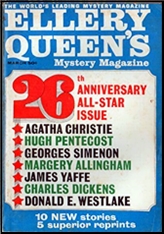
JAMES YAFFE “Mom and the Haunted Mink.†OK, if played a a game to trick the reader. But the police detective telling the story to his mother must certainly have recognized the name-switch at once. Pfui. (0)
AGATHA CHRISTIE “Miss Marple and the Golden Galleon.†Original title: “Ingots of Gold.†[The Royal Magazine, February 1928]. The theft of gold bullion is solved by knowing gardeners never work on Monday. (2)
DONALD E. WESTLAKE “The Sweetest Man in the World.†Another insurance company fraud, mixed with impersonation, embezzlement, and murder. (3)
CHARLOTTE PERKINS GILMAN “The Yellow Wallpaper.†[First appeared in New England Magazine, January 1892.] First published over 60 years ago; “a classic tale of horror.†A woman is driven insane by wallpaper. Not very effective. (2)
ELLERY QUEEN “The Adventure of Abraham Lincoln’s Clue.†[First appeared in MD, June 1965, as “Abraham Lincoln’s Clue.â€] Items with the signatures of both Lincoln and Poe turn out to be forgeries, but the stamps are worth a fortune. (4)
RICHARD DEMING “The Jolly Jugglers, Retired.†Bank robbers take over restaurant. Obvious from beginning. (1)
JOSEPH MATHEWSON “A Stranger’s Tale.†The fresh wrinkle in this story of identical twins is the same old crease. (2)
HUGH PENTECOST “The Monster of Lakeview.†Uncle George’s dog is is stolen for laboratory and saved by a befriended man-child. (3)
MARGERY ALLINGHAM “Bubble Bath No. 3.†[First appeared in Argosy (UK), July 1956, as “Three Is a Lucky Number.â€] Wife-killer is foiled in third attempt. (3)
FRANK SISK “The Strange Adventure of Charles Homer.†The estate Surcease Isle becomes Circe’s Isle, but Homer escapes. A weird fantasy. (3)
CHARLES DICKENS “The Pair of Gloves.†[First appeared in Household Words, September 14 1850, uncredited.] Primitive police procedure; gloves have nothing to do with murder. Of historical interest only. (0)
PRINCESS ZAWADSKY “Third Act Curtain.†An actor masquerades as a notorious killer. (3)
JOAN KAPP “Mystery, Movie Style.†A lady jewel thief scares off two others. A fun story. [The author’s only published crime story.] (5)
GEORGES SIMENON “Inspector Maigret Directs.†[First appeared in English in Argosy (UK) November 1961, as “Under the Hammer.â€] Maigret puts all the characters in a murder-drama through their paces continuously until the culprit is revealed. ( 4)
WILLIAM BRITTAIN “Mr. Strang Gives a Lecture.†A high school clears a student framed for robbery. Not a very promising series start. (2)
Tue 12 Jul 2022
A Movie Review by Dan Stumpf: DARK AND STORMY NIGHT (2009).
Posted by Steve under Mystery movies , Reviews[2] Comments
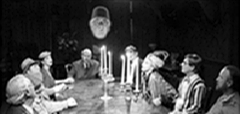
DARK AND STORMY NIGHT. Bantam Street, 2009. Jim Beaver, Jennifer Blaire, Larry Blamire, Bob Burns (as Kogar the Gorilla) Dan Conroy, Robert Deveau, Bruce French, Betty Garrett, Trish Geiger, Brian Howe, Marvin Kaplan, and H.M. Wynant. Written and directed by Larry Blamire.
A Larry Blamire thing.
That should be description enough for those familiar with The Lost Skeleton of Cadavra (2001) and Blamire’s other delicious send-ups of films no respectable critic would deign to notice. Night, however, offers a thin patina of low-budget Class missing from Cadavra, and a script well-attuned to the niceties of old Dark House movies.
The story line here follows the classic Cat/Canary recipe: mix greedy relatives on hand for the reading of the will; stir in a crooked lawyer, wise-cracking reporter, and a clutching hand or two, and heat until it all catches fire quite nicely.
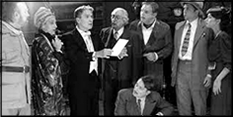
Don’t get me wrong, like most of Blamire’s things, Night is far, far from perfect. Often it’s not even very good. Running jokes get run into the ground, and the level of hysteria frequently rises too high for comfort. Then again, while director Blamire lavishes B-movie (1930s variety) atmosphere on this, writer Blamire sometimes forgets to be funny.
But this is balanced by some genuine wit, rapid-fire dialogue in the Howard Hawks tradition, and an attitude of affection for the genre that puts the viewer in a receptive mood when good jokes (and there are many) do come along.
Which may be the key to the charm of any Blamire thing; it’s done with love.
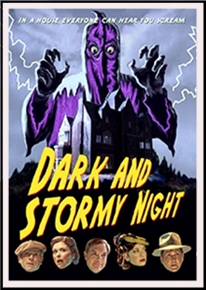
Mon 11 Jul 2022
Mystery Review: ERLE STANLEY GARDNER – The Case of the Grinning Gorilla.
Posted by Steve under Reviews[9] Comments
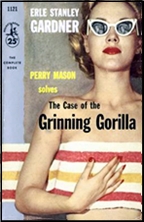
ERLE STANLEY GARDNER – The Case of the Grinning Gorilla. Perry Mason #40. William Morrow, hardcover, 1952. Pocket, paperback, 1956; many reprint editions. Ballantine, paperback, 1982. TV Episode: 29 April 1965 (Season 8, Episode 28).
Hang on tight. You’re going to keep your seat belts on all the while you read this one.
It begins innocuously enough. On a whim Perry Mason buys at an auction a box containing the personal effects of a young woman who recently committed suicide, presumed lost at sea with no body found. Among the items in the box, however, are five volumes of the woman’s diaries. When it is known that he has them, he quickly has a very handsome offer for them. Does he sell? Need you ask?
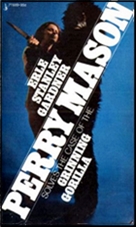
As it turns out, the woman’s employer is an eccentric millionaire part of whose home has been transformed into a zoo for all kinds of monkeys, chimps and apes – including gorillas. And when the man is found dead, Mason’s client claims that she saw a gorilla kill him with a knife. When Mason goes to the house, he finds the gorillas on the loose and himself face-to-face with the most ferocious one of them.
Neither Hercule Poirot nor Sam Spade had this kind of narrow escape.
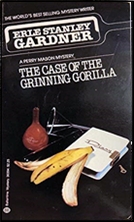
Given the hypothesis, though, Gardner is in top form with this one, his usual smooth but idiosyncratic writing combining with a plot perhaps even more complicated than usual. Unfortunately the trial scene in this one is marred by a tedious recitation of the fine points of testing for human blood versus that of a gorilla, and a fairly ridiculous ending that will remind you of one of the worst facets of B-movie jungle movies. (Dan Stumpf, please take note.)
On the other hand, Perry and Della Street do find time to share a long kiss, and later on we find Perry’s arm holding her somewhat affectionately about the waist. I have no idea where Gardner thought this might lead, but I’m fairly sure it was nowhere fast.
Mon 11 Jul 2022
A Mystery Review by LJ Roberts: BRENDAN SLOCUMB – The Violin Conspiracy.
Posted by Steve under Reviews1 Comment
Reviews by L. J. Roberts
BRENDAN SLOCUMB – The Violin Conspiracy. Anchor, February 2022.
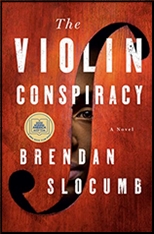
First Sentence: On the morning of the worst, most earth-shattering day of Ray McMillian’s life, he ordered room service: scrambled eggs for two, one side of regular bacon (for Nicole), one side of vegan sausage (for him), one coffee (for Nicole), one orange juice (for him)
Ray McMillian is black and a classical violinist. He has overcome poverty, racism, and the censure of his own mother. Two people have been his principal support; his Grandma Nora who gifted him the violin which had belonged to his once enslaved great-great-grandfather, and his violin teacher, Janice Stevens. After being in New York City with his girlfriend Nicole for several days, he is about to leave for the Tchaikovsky Competition in Russia when he discovers his beloved violin, confirmed to be a Stradivarius, has been stolen and is being held for a $5 million ransom.
It is a gripping read when one starts a book at 10 p.m. and reads straight through until 3 a.m. From first page to last, this is a book impossible to put down as it is so much more than a mystery.
While a crime has been committed, this is a book about racism and greed. But it also shows that with the love and support of just a few people, as well as determination, perseverance, and passion, one can accomplish great things. Still, too, there is a mystery within the mystery. Much of the story’s tension arises from the question of who really owns his $10 million Stradivarius. This becomes a battle between Ray, his family, and the Marks family whose ancestors owned Ray’s “PopPop.”
An unusual format takes one from the present to Ray’s childhood and progressively forward to the present. One is drawn into Ray’s life. From his experiences with casual and overt racism, from beginning with a school violin to the Strad, one grows as Ray does. However, it is the descriptions of Ray’s playing and performing that are truly transportive. Comparisons to the book/series The Queen’s Gambit about a young, female chess master, are to be expected.
The Violin Conspiracy is a remarkable debut. It is not a perfect book, yet one really doesn’t care. It is a book that leaves one thinking long after closing the covers and may even draw one back for a second reading.
Rating: Excellent.
Sun 10 Jul 2022
A Movie Review by David Vineyard: DUEL ON THE MISSISSIPPI (1955).
Posted by Steve under Action Adventure movies , Reviews[8] Comments
DUEL ON THE MISSISSIPPI. Columbia Pictures, 1955. Lex Barker, Patricia Medina, Warren Douglas, Craig Stevens, John Dehner, Ian Keith, Celia Lovsky. Screenplay by Gerald Drayson Adams. Directed by William Castle.

The Western movie dominated Post-War Hollywood into the early 1960’s, and there were several sub=categories of the form. including the Northwestern (usually Mounties and sometimes the Klondike gold strike), the modern Western set in more or less contemporary times, the Frontier, the Trail Drive, the Gunfight, the Cattleman vs Sheepmen, Cavalry vs Indians, the Mountain Man, the Empire Builder, Old California, and the Southern (which sometimes was a pirate movie or historical, but also sometimes a Western as it is here).
Each had its own tropes, but the Southern was perhaps the only variation on the Western to regularly include sword fights as a staple, outside of the Old California story. You can probably count the number of sword fights in regular Westerns, on the fingers of one hand, though they did show up in some of the old Cisco Kid B films.
But in the Southern they were commonplace regardless of the historical era in films like Mississippi Gambler, The Iron Mistress, and Gambler from Natchez (the latter a retelling of The Count of Monte Cristo).

Duel on the Mississippi has two of them, one with epee and the other machetes.
The year is 1820 and the place Louisiana, and save for their presence in the background nary a word is ever mentioned about slavery. It seems to have entirely escaped the notice of the film makers, I think there is only one black actor, an actress, with a spoken word, not even a “Massa†to be cringed at.
Anyone not knowing history would be at a loss to know all those black actors weren’t playing paid hands.
I guess one way to avoid the elephant in the room is to completely ignore it is there.
That out of the way, this is a handsome little Technicolor Southern adventure film in the more or less Frank Yerby tradition of some sex, some arrogance, violence, a bit of class consciousness, and a fiery heroine vs a stalwart hero. He’s a better writer than it suggests but in some ways Yerby was the Mickey Spillane of the historical novel. He brought a new level of sex and violence to the genre in the Post War era just as Spillane did the mystery.
He didn’t write this one, but if you know his work you will understand why I mention him in relation to it.

The stalwart hero is Andre Tulane (Lex Barker), the handsome and only a bit arrogant son of French sugar cane planter Henri Tulane (John Dehner). It seems the Tulane’s and other planters are under attack from the Delta Men stealing their harvested cane, raiders from the bayous led by Hugo Marat (Warren Douglas) who is partnered with riverboat owner Lili Scarlet (Patricia Medina) and her father old Jacques Scarlet, one of Lafitte’s pirates pardoned after the War of 1812 by James Madison.
The wealthy landowners won’t allow Jacques to buy land, and Lili hates them for it.
Woman scorned and all that. French woman scorned at that. Red-haired French woman scorned too. The Tulane’s know how to pick an enemy.
When Andre captures Lili during a raid she escapes, but then he learns his father’s loan has been sold to Jacques Scarlet’s daughter and she is taking him to court. To save his father from going to jail for failing to pay the $30,000 he owes Andre agrees to become Lili’s bonded slave, but not before challenging murderous duelist Marat to a duel at sunrise.

The plot is pretty predictable, Andre and Lili loathe each other so they fall deeply in love through all the hate. Marat is jealous and plans to cheat Jacques and have Lili for himself. There is a crooked mill owner who sold Lili the mortgage on the loan in cahoots with Marat who sets Andre up to be killed, and finally there is a big raid on the raiders hideout when Lili proves her worth, and Andre’s Mother (Celia Lovksy) warns that it is time to learn to accept people for what they are and not their birth.
Craig Stevens does get to sword fight with Barker as he practices for the duel, as does Dehner. Dehner is pretty good, so is Barker, I suspect Stevens is a stunt double. Douglas isn’t bad in his scenes either. Decently choreographed sword and machete fights are bonuses.
Barker was no great shakes as an actor, but he was tall, handsome, hit his marks, athletic, and had a high IQ plus spoke numerous languages and grew up a rich kid rejecting it to make it on his own as an actor. He was always at least adequate and often more than that and the camera liked him. He might not bring the skill of a John Payne or the charm of a Dale Robertson to this kind of role, but he didn’t embarrass himself or the viewer and he was always believable as a hero.

Medina is a bit flowsy-looking for this part, or maybe the Technicolor isn’t flattering, but she is very good playing the kind of role she could play in her sleep. She does an acceptable Rhonda Fleming/Virginia Mayo substitute.
Douglas is always a decent villain. Nothing spectacular, but capable, though it’s a little tough when a man his size has to do a threatening face to face scene with Lex Barker towering over him. To Douglas’s credit he almost pulls it off, thanks to having a gun in one hand, and quite a bit of dialogue building him up as more dangerous than the movie ever shows.
I don’t generally rate movies, but this one is a B- or C+ in a forgiving mood, which isn’t at all bad for what it is. Adams could do this kind of plot all day and Castle was a competent director, sometimes more, before he started relying on gimmicks.
In the right mood and to kill a short hour and a half Duel on the Mississippi isn’t bad, and distracting enough that I didn’t once wonder where Cheetah, Winnetou, or Dr. Mabuse was once despite Barker’s presence.
